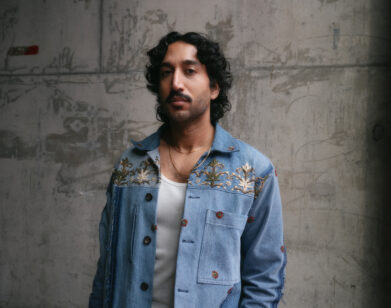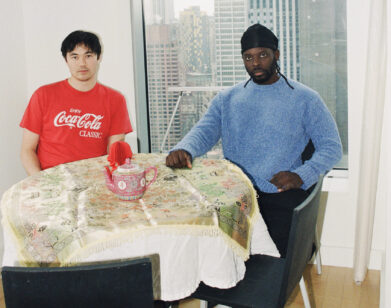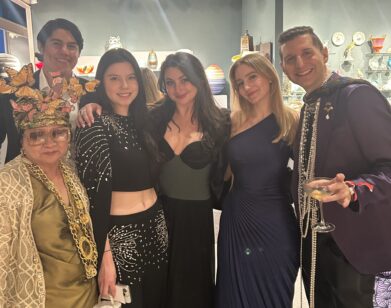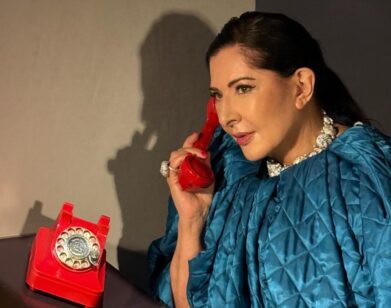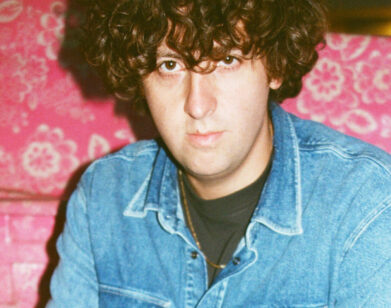Philip Taaffe
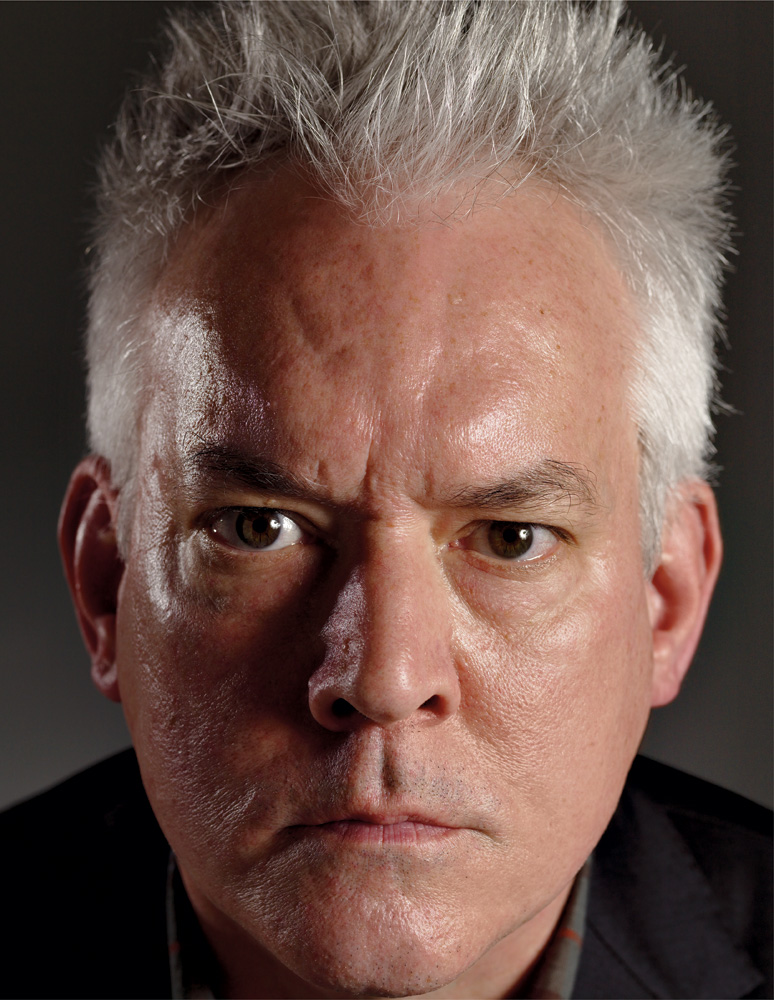
Philip Taaffe is one of the very best painters in the world. You don’t have to believe just us—Roberta Smith mentioned that fact recently in The New York Times. He had his first solo exhibition in New York in 1982, coming of age with a formidable generation of artists and musicians that included Diego Cortez, who is today a former artist, a pianist, a curator, and an advanced tourist. Taaffe is also an advanced tourist, having spent a great deal of time in the Middle East, India, Morocco, and South America—and he lived in rather extraordinary circumstances in Naples in the late ’80s and early ’90s, while -Cortez was just offshore, holed up in Capri. The two old friends sat down recently to talk about the state of the world and art.

DIEGO CORTEZ: I want to talk about the ideas that go into your paintings. In the early days, I felt that the primary misconception about your work was that it was decorative. I would argue with people about the ramifications of diversity in your work—the cross-cultural concerns. It’s such a beautiful opportunity in our time to be able to access all the different world cultures, and I feel that’s the essence of your work: to make comparison studies of different cultures.
PHILIP TAAFFE: Well, it’s an opportunity and a curse. The materials are taken from the investigated remains of lost cultures. The difficulty is in recovering them in such a way as to speak to our present circumstances.
CORTEZ: When people say that David Byrne is a world musician, they are really saying that artists are musicologists or anthropologists. I think we are both interested in a postmodern way of looking at the world, an aesthetic deeply embedded in music and world cultures . . .
TAAFFE: An artist makes something to be -physically experienced by another person. It’s a raw, freely chosen, interpersonal relationship between the maker and the viewer, so it’s close to what a musical composer does, or a poet or a dancer. It is coming out of one’s inner being.
CORTEZ: Even if your work is very design-oriented, it isn’t design. Do you worry about the issue of decoration, or these kinds of issues?
TAAFFE: No. I think the important distinction is that art has to do with expression, with summoning an inner state. Mine is a deeply personal approach. I want to draw connections between those things I love. I have a fairly unwieldy set of concerns that go into determining what I do in the paintings, such as the history of the decorative, patterns of cultural migration, Islamic art and design, Byzantine architecture, the annals of natural history, as well as contemporary painting. All of these things are filtered through my own sense of cultural urgency. How I proceed with the work has to do with how I respond to this instinctively chosen mass of materials. I’m weighing many things and making many decisions before I even get started on a painting.
CORTEZ: I see the main issue in your work in its dialogue with the history of art. This brings up the question of the rejection of the new—or what people perceive to be new.
TAAFFE: It’s not a rejection of the new. It’s a rejection of the expectations surrounding the new.
CORTEZ: You’ve gone historical as opposed to futurist. Most art is concerned with the new—a new production of new things in new times. I feel you largely reject these notions of the new.
TAAFFE: Essentially, I’m trying to make a primitive painting. I’m trying to summon the archaic. I want to enter into a primitive situation. This is my protest against the sensory deprivation that we experience, which is due to this tendency towards globalization, towards homogenization, towards the generic—a technological standard rather than an aesthetic standard. I’m mining history, trying to regenerate a pictorial situation that is more humanistic. It’s not about commodification, it’s not about fitting into some sort of corporate structure. It’s opposed to that direction.
CORTEZ: I came away recently from three days of workshops with design students at the Benetton Fabrica in Italy, and I was a bit exasperated by the chorus of the word new being thrown at me. Today there seems to be a mania to create something new just for the sake of making something new.
TAAFFE: Well, design is meant to grab you and win you over. It is meant to function in a way so as to make life easier. Obviously painting has to do with something quite beyond that. It’s not about communication per se. It doesn’t necessarily telegraph anything. It’s more about understanding who we are and where we come from.
CORTEZ: But are you trying to make something new as a contemporary artist? When I first met you, I felt like your rejection of the new was the new thing about your work.
TAAFFE: That’s an interesting way of putting it. For me, the whole idea of the radically new is tied to a close reconsideration of older sources. I like to give myself over to those sources, as points of origin, in order to bring things forward. My approach requires me to internalize my sources as much as possible in the hope that new themes might emerge. The material has to be internalized in order for it to live again. Ultimately, paintings reveal themselves on the basis of what they are. They are inseparable from the physical process that goes into their making.
CORTEZ: Brian Eno once said that the artist of today is first and foremost a curator. If there’s any artist that I know who is a curator at heart, it’s you. What does it mean to be a curator?
TAAFFE: To look after things, to take care of things.
CORTEZ: Museums have traditionally been places that protect the art object. But in the last 40 years, a new type of museum has emerged—the Kunsthalle or alternative space which only presents temporary, contemporary shows. Yet art is not just about the future—it is about the future and the present, but it also can’t forget the past.
TAAFFE: I don’t want to fetishize the past. I want there to be a natural sequence coming out of a synthesis of the ideas and information that I gather together as a result of the research I do, as a result of looking at things that are in the world. I’m trying to bring forward signs or signals based on what I see and my responses to these things. I’m trying to leave a trail that will be useful to other people in the future. It has to do with making something that contains a synthesis of the information, and then consequently to make one’s deliberations visible, to allow other people to follow them. That’s how I see my role. It’s not pure scholarship.
CORTEZ: Our recent pop-music icons, even the most radical ones, like Björk or Caetano Veloso, often have to present themselves as happy and make positive work because they have such a large young fan base to whom they feel responsible. They can’t be too negative. Now, criticism is basically a negative act. As you know, critics are neither pop stars nor popular. They are the gripers. But someone has to speak up and say no to this and yes to that.
TAAFFE: I think that very often the role of the artist has been to define something in a circumscribed way, by stating what it is not. For example, Ad Reinhardt does this with his method of describing how a painting should operate. He would say, “It’s not this, it’s not that.” He recited a whole list of what a painting wasn’t.
CORTEZ: The optics that you use in your work allude to a kind of hallucinogenic, electric state of mind—like if you have a high fever and your vision diminishes to only raw pixels. Your paintings are closely related to luminosity. A light that reverberates.
TAAFFE: Yes, light is the key.
CORTEZ: I’ve always hated the word spirituality, but now I accept the word, and I think it’s a useful term. It just means so many things. And actually, most of the things it does connote are beautiful things.
TAAFFE: It depends how it’s used. Usually such things are better left unstated.
CORTEZ: I’m just looking for a better word, more like electricity. How would you define spirit?
TAAFFE: These are truly ecstatic concerns—wanting to be in touch with, and to bring outside of ourselves, in some way, our inner god. It’s about having an awareness of the possibility, and the perception to know what to do with it.
CORTEZ: Well, isn’t spirit just life?
TAAFFE: Certainly. It’s the life force.
CORTEZ: I just walked to your studio for the first time in 10 years, down Sixth Avenue, which was disgusting. All this new lousy architecture. And, of course, I thought immediately . . .
TAAFFE: “This is what he’s going to want to talk about.” [laughs]
CORTEZ: They’re surrounding your studio with a glut of modernity.
TAAFFE: It’s visually depraved. The contemporary architects who are building these nondescript buildings are using modernist ideas—such as Mies van der Rohe and the Bauhaus—but they’re leaving out the sensibility. They’re using it as an excuse to get away with doing things on the cheap. It’s a debasement of these modernist ideas and an emptying out of modernist architectural thought. It doesn’t have to be that way. Cities could be spectacular. I’m a great believer in the urban environment.
CORTEZ: In your work, there’s still a sense of complexity. You don’t run to the minimal, you haven’t become a Zen Buddhist as a rejection of this world. You still embrace the complicated nature of things like the baroque. That is surprising for a person who I think rejects this glut . . .
TAAFFE: But there is a tendency in my work toward minimalism, in terms of stripping away the unnecessary. I am seeking a tightly ordered gestalt, usually. I’ve always felt a strong affinity towards Mondrian’s work. I understand the importance of those subtle planar and linear modulations he made in the course of building up the incredible visual tension in his work. If you ask what the cultural ramifications of a painting might be, I would say we have an extremely good paradigm in Mondrian. I have also been very influenced by the Japanese concept of space—the preciousness of space, and how one’s environment can be shaped to make the most out of limited resources. That’s the kind of thing we need to look at again—how momentous the results can be from very subtle changes.
CORTEZ: The great achievement of Zen Buddhism, and all of its cultural expressions in painting or the tea ceremony or rock gardens, is a rejection of earlier Buddhist ideas which were dependent
upon narrative—all the mythological creatures that populate the Buddhist galaxy. Zen insisted on the real located in nature. Then it was an abstraction and aesthetization of nature as well.
TAAFFE: It became more about celebrating the beauty of the transitory, the unique shape of each moment and how surprising this is.
CORTEZ: They tried to rid themselves of mythology—humans as supermen. It then got down to how human beings can better relate to nature.
TAAFFE: Do you believe that painting can give us clues as to how to deepen our relationship with nature?
CORTEZ: Yes, I still think that art can take us there. Even after seeing so much bad art in the last few years, it still seems possible that one can be led to the right places—
TAAFFE: So you haven’t given up hope.
CORTEZ: No, I haven’t given up hope because there are always great artists, great minds, and great ideas. New ideas are what give you hope. You have to base your opinions on the quality of the ideas in the artworks. If you are mostly interested in the politics of the art world, the artist’s persona, or the art market, you will find yourself distracted from the essentials. These things mean little to me. But they obviously mean a lot to other people. There’s another glut—a glut of bad priorities.
TAAFFE: Ideas in art may be quite evident, and sometimes they’re hidden. Sometimes they’re simple, and sometimes they’re quite complex. Great works of art can be based on very simple ideas, but it’s all in the making, isn’t it? It’s in the facture. Art exists through the act of making. It has to somehow be made manifest to another person. It has to do with what one wants to see manifest, what one wants to bring into the world, what one desires to have exist.
CORTEZ: But that’s like the joy of handling things and touching things. It’s like having sex. It’s the joy of physicality. Yet you still start out with ideas or designs.
TAAFFE: Although all of it is completely intuitive.
CORTEZ: I would say that most serious artists have a pretty complete idea of what they’re going to do before they do it.
TAAFFE: Sometimes those formative ideas can be put into words, but then they’re somehow less interesting than when they’re actually being worked out in the process of making the painting. Usually I make a fair amount of studio notes, procedural notes—Do this, do that. I come up with a set of operations I’ve determined I will execute, and that’s what I do. But at a certain point, the painting takes on such a strong identity of its own that I am merely coaxing it into its final state.
CORTEZ: I look at your early work as being more about the unique event. Each painting had a very strong singularity. You could walk into an exhibition of 10 paintings by you, and you would see 10 completely different ideas. Each one was contained in a cell, a unique thing—a closure. Now, in your later work, things have become more intermixed, more open. It’s like an open sea; everything is now floating in space. I wouldn’t say that your work has become serial—it’s not that. But there’s some new sense of expanse, like seeing a starry galaxy or an open sea.
TAAFFE: The ambiguities of the spaces have become more complex, more faceted. I have more to take into consideration now than ever before. Consequently, I would say there is a greater degree of compression in the work.
CORTEZ: We’ve traveled a lot together.
TAAFFE: Yeah, that trip to Peru was a doozy.
CORTEZ: [laughs] I know.
TAAFFE: I was also thinking about the times we spent together in Seville during Holy Week—Semana Santa and the idea of spectacle in art and religion. This choreography surrounding the Passion of Christ.
CORTEZ: And where does that history fit today?
TAAFFE: Exactly. What do we do with this tradition now? That’s an exemplary situation as far as I’m concerned, what goes on in Seville during Semana Santa. It’s profoundly sensual—the colors and the sound and the light. The smell of incense, the burning candles in the evening. It’s all this sensuality coming from a solemn religious tradition. It’s the conflation of the two that truly gives it the magic. One feels the Muslim presence there as well . . .
CORTEZ: Flamenco voices overlap with Catholicism. Then you have the Bacchanalian aspect of it—a massive rave, people assembling in street masses, then spinning off from a particular procession to hang out, eat and drink, or flirt. One focuses in and out of reality and spectacle as you segue in and out of this network of street theater. I was also impressed by the cultural blend of different social classes. Throughout the Mediterranean, there’s a tradition of street festivals to bring together people across hierarchies of class. Holy Week in Seville is a romantic, nostalgic look at the past and its traditions, but it also has a secular dimension. This is partly due to the blend or blurring of religions and their pagan past—not only Catholicism, its sponsor. I also recall the wood or polychrome sculptures of the Virgin or Christ and his Apostles, and their fragility. When carried in the slow left-right-left-right cadence by young Sevillians, a kind of shiver and shake of the male or female body is witnessed—the candles shivering too. This light creates a flickering sensation, as in cinema, a kind of hallucinogenic . . . The sculptures were brought to life through this ritual enactment . . .
TAAFFE: That’s the feeling of it, yes. The power of the baroque!
CORTEZ: The church was always very adept at incorporating all the different artistic disciplines. What we call the church is actually an assemblage of different artistic forms, whether in its Biblical literature, or sculpture, painting, music . . . As Semana Santa proves, it is a performance art. You see the roots of religion in its fragmented components.
TAAFFE: I can remember accompanying that elderly woman whose husband had recovered from this terrible illness and her giving thanks to La Macarena—the Virgin Mary statue that she had prayed to on behalf of her husband. She decided that she would walk the entirety of this procession in her bare feet, and there were people surrounding her, helping her do this. It was an act of gratitude and penitence, and it was very moving. And you witness its vulnerability—its fragility. It’s very dignified, but it’s also very awkward at the same time.
CORTEZ: More than awkward. It’s more akin to a punk concert, where the lead singer dives into the mosh pit. In this case, the embodiment of Christ or the Madonna is forced into throngs of people, including hundreds of drag queens . . . who are ever so fond of La Macarena. The drag queens in Seville model themselves on La Macarena.
TAAFFE: It’s those pearlescent tears that you see trickling down her tender, anguished cheeks. [laughs] We visited the chapel in Seville, the Hospital de la Caridad, with murals by Valdés Leal. In a context such as that, one does feel the healing power of art. These are paintings I can venerate as I would an icon—not necessarily as religious paintings, but as an act of veneration, where I want to go back to see these works over and over again, not only to learn from them, but simply to re-xperience them. It’s this experiential component that fills the mind and the heart with this lived action that took place in order to make this thing. One can feel that and -appreciate it over and over again in new ways. This is really the function of art—this is what we aspire to. And we spoke about how that artist functioned in a shamanistic capacity, as a healer—especially in that context. I think that is the role of the artist in society—the cultural role of the artist is to perform a healing function.
CORTEZ: We haven’t talked about the art market. I’m as tired of hearing about it as you probably are, but is there anything you want to say about the art market?
TAAFFE: As far as I’m concerned, it’s like worrying about the weather. I’m not so interested in the effort that it takes to have a self-promotional outlook. I believe in being quiet and making my work and just trying to make discoveries and let the painting evolve. I’m just going to continue doing what I do.
CORTEZ: So you don’t want your work to be connected with political or social upheavals?
TAAFFE: Well, of course it’s connected—that’s somehow unavoidable. But it’s not something I dwell on very much. Although I don’t understand why a Mark Rothko painting—as much as I love Mark Rothko—has to cost $73 million. I mean, I think $14 million is a pretty reasonable sum of money for a good Rothko painting. What’s disturbing about this present moment is that these prices have been so out of control.
CORTEZ: That has little to do with the painting itself, and more to do with the person who buys it—that they would want to spend that kind of money.
TAAFFE: It’s hard to fathom the psychology of the economics of art. I think it’s probably been harmful to younger artists. I don’t quite understand it, and I don’t necessarily want to understand it.
CORTEZ: It’s like an oil spill, or a kind of nuclear plant meltdown. It’s what happens when something goes wrong.
TAAFFE: There’s probably an obscene dimension to a lot of art that tries to draw attention to itself by any means necessary.
CORTEZ: I think what happened in the last 10 or 15 years in the art market is that all the players—and that includes artists, dealers, art advisors, everyone—basically became dealers. We’ve had old-school collectors morph into speculators, flipping works. We’ve seen auction houses buying works directly from artists or from sleazy middlemen. The last step before the crash was the artists themselves supplying the auction houses. Dealing themselves, you know? The art world is as unregulated as any financial market there is. I mean, when you do a real estate deal you have to go through all kinds of checks and balances. You have to be governmentally approved on every level. But to do an art deal for $15 million, you just send a one-page invoice and wire the money, and that’s it. Basta. What are your methods for connecting to the community outside of the art world?
TAAFFE: For me, this has nothing to do with art, or what artists should think about. What excites me and what I find most compelling is clearly not what excites other artists, and so it’s a personal decision. It comes from my own idiosyncratic background and what I’m drawn to. Maybe this is a result of having lived in Naples during a formative period of time, being exposed to that kind of archaeological situation. I’m interested in telling a unique story in a very intense way. I will do a lot of research and create a lot of material for use in one painting. And then I go on discovering and working with a whole other range of material in another painting. I’m interested in a fairly comprehensive and orchestrated synthesis that might bring about a new situation consisting of this hidden material. I’m interested in hidden source material. You can’t find these things on the Internet or in the street. They are things that I have deliberately gathered around me to bring them close enough to examine. I investigate the plastic connections I’m capable of making that have to do with visual-art-making.
CORTEZ: It’s funny you say plastic . . .
TAAFFE: The plastic arts.
CORTEZ: Of course, I knew what you meant, but it’s funny because . . .
TAAFFE: There’s no plastic. I don’t have any plastic in my life. [laughs]
CORTEZ: No, I see that your work is actually the antithesis of plastic. And that much of the work of other contemporary masters is the embrace of plastic, in a kitschy sort of comical way. This world of plastic in which we are drowning.
TAAFFE: I’m tired of that. I think that’s a tired approach to art-making. It’s like pandering to some kind of perceived audience that . . .
CORTEZ: That’s why I’m bringing it up. That’s why I’m trying to dig into this a little bit, perhaps because I feel that way too.
TAAFFE: I’m very tolerant of other art and other artists. But what I truly appreciate, what I truly admire in contemporary art, is work that takes on more than it can sometimes handle—art that gets in over its head.
CORTEZ: Somehow I feel like so many of the artists have gotten away with mere joking.
TAAFFE: With doing too little, yeah.
CORTEZ: I’ve always been leery of comical artists because I think oftentimes they’re hiding the fact that they’re not that talented. For example, with Martin Kippenberger, I always thought he was a kind of poor man’s Sigmar Polke—also a humorist—but Kippenberger used humor to get away with things he couldn’t master. His recent MoMA show vindicates my thoughts. In spite of it being a well-selected and beautifully installed show, the work itself rings flat, thin, and hollow.
TAAFFE: I think he said, “I may be a third-rate artist, but I’m the best third-rate artist ever!”
CORTEZ: That’s probably correct. A lot of these irascibles come from an initial take on the art world, that it is a stuffy or elitist world, so they see themselves as being somehow radical in undermining that. That’s why their work or attitude has to be comical or adolescent.
TAAFFE: Well, it’s also fixating on the idea that pop art somehow was a way of defeating abstract expressionism. You know, I’m not so interested in this series of ruptures, where minimalism took over pop art, and then neo-expressionism was a triumph over that. I’m not interested in rupture—I’m interested in healing, bringing things together, building bridges. Not dismissing what has come before as a kind of modernist precedent, where one thing has to be broken in order to achieve something else. I don’t believe in that kind of attitude. I think we’re beyond that at this stage.
Diego Cortez is director of the Luciano Benetton Collection, in Treviso, Italy, and the Freeman Family Curator of Photography at the New Orleans Museum of Art. He lives in New York.

